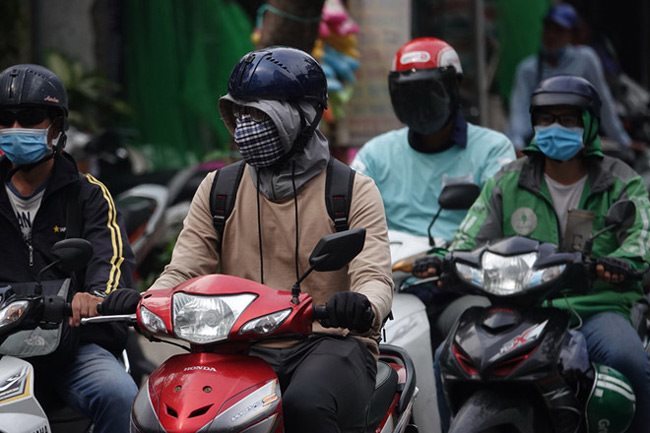 |
| Motorcyclists wear face masks and eyeglasses when traveling on a street. Prime Minister Nguyen Xuan Phuc has ordered the Ministry of Natural Resources and Environment and the governments of Hanoi and HCMC to promptly take effective solutions to address the worsening air pollution - PHOTO: TNO |
Speaking at a regular Cabinet meeting on October 2, the prime minister said that it is necessary to consider relocating plants out of the inner-city areas, limiting private vehicles, controlling the number of old vehicles and increasing the number of trees to improve air quality.
PM Phuc also asked the ministry to enhance its collaboration with the Hanoi government to address the current air pollution and install efficient monitoring stations.
Speaking of the causes of the air pollution in major cities, Deputy Prime Minister Trinh Dinh Dung said that the rise in the number of private vehicles on the streets had resulted in severe exhaust emissions during traffic jams.
The deputy prime minister pointed out that at the working session with leaders of Hanoi City on October 1, he told the city to take measures to resolve the problem, including speeding up some key traffic projects to put them into operation, boosting public transport and restricting private vehicles.
Addressing a press briefing on October 2, Deputy Minister of Natural Resources and Environment Le Cong Thanh said that HCMC and Hanoi, the country's two biggest cities, had planned to install extra environment monitoring stations to issue timely advisories of environmental issues to residents.
A long-term plan to improve the quality of air and reduce fine dust is being worked out, Thanh said.
On air quality monitoring apps, Thanh said that some foreign websites or apps, such as AirVisual, have gathered information from different monitoring stations. However, standardized monitoring devices give more reliable information.
As such, Thanh noted that indicators on websites focused on air quality are purely for reference, adding that residents should search for precise and official information on the cities’ websites or that of the Vietnam Environment Administration.
Air quality depends on location and time. If monitoring stations are installed near garbage dump sites, the volume of air pollutants and fine dust will be high, Thanh remarked, adding that these areas do not represent the whole city.
Hanoi City vice chairman Nguyen The Hung pointed out that over the past few years, during the period of seasonal shifts, Hanoi City always suffers air pollution.
Measurements are frequently sent to the monitoring center from 11 monitoring stations citywide. These measurements are also published in their entirety, he explained.
Hanoi City will raise the number of environmental monitoring stations in the city to 25 by 2020, deploy some solutions to handle waste to avoid affecting air quality and tighten control over the rise in the number of private vehicles, according to Hung. SGT
 PM Nguyen Xuan Phuc has ordered the Ministry of Natural Resources and Environment and the governments of Hanoi and HCMC to promptly adopt effective solutions to address the worsening air pollution, the local media reported.
PM Nguyen Xuan Phuc has ordered the Ministry of Natural Resources and Environment and the governments of Hanoi and HCMC to promptly adopt effective solutions to address the worsening air pollution, the local media reported.